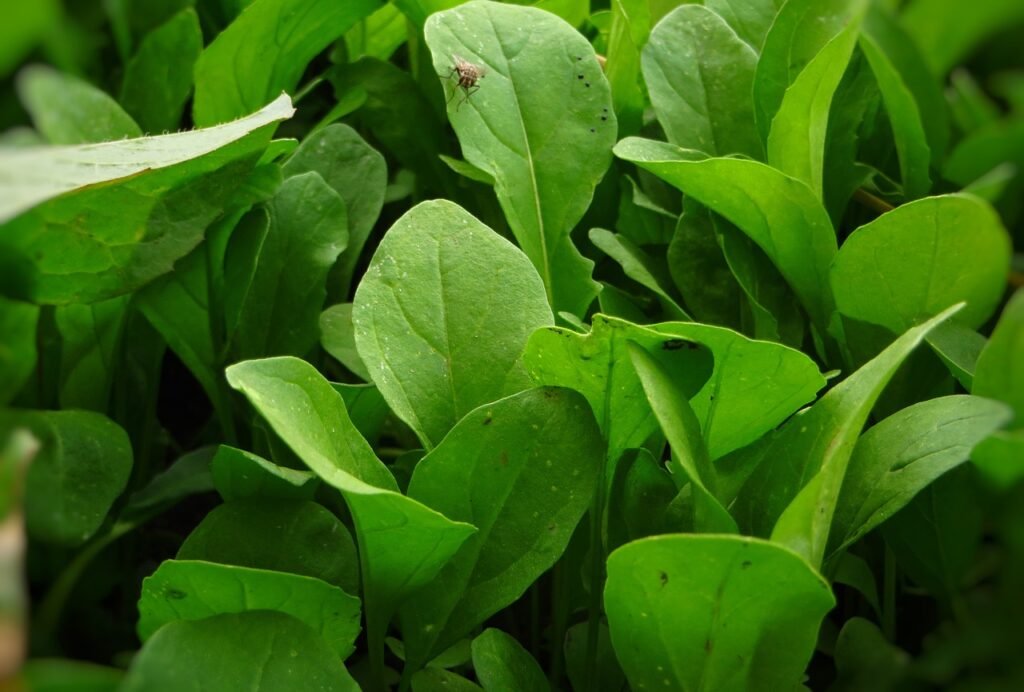Arugula Growing Guide From Seed To Harvest To Health Benefits

Looking to add a nutritious and flavorful green to your garden? Consider arugula!
This guide covers everything from growing arugula from seed to harvest to its health benefits.
Learn about ideal growing conditions, planting steps, caring for your arugula plants, and preventing pests and diseases.
Find delicious recipes and alternative uses for this versatile leafy green!
What Is Arugula?

Arugula, scientifically known as Eruca vesicaria, belongs to the plant family Brassicaceae. It is a versatile leafy green that offers a peppery flavor profile and is highly valued for its culinary uses.
Arugula can be grown as an annual or perennial plant, depending on the growing conditions. This nutrient-dense green leafy vegetable is packed with vitamins A, C, and K, as well as folate and calcium, making it a fantastic addition to a healthy diet.
With its slightly spicy taste, arugula adds a zesty kick to salads, sandwiches, and pasta dishes. Not only does it enhance the flavor of various dishes, but it also provides numerous health benefits, such as supporting eye health, boosting immunity, and promoting bone strength.
How To Grow Arugula From Seed?
Growing Arugula from seeds is a rewarding experience that requires proper planning and care. Understanding the germination process and ideal growing conditions is crucial for successful cultivation.
- To start, select a well-draining pot or garden bed for planting the arugula seeds.
- Prepare the soil by mixing in compost to provide essential nutrients for the seeds to thrive.
- Sow the seeds thinly, about ¼ inch deep, and lightly cover them with soil.
Arugula thrives in partial shade but also requires sunlight for at least 4-6 hours a day. Water the seeds regularly, keeping the soil moist but not waterlogged. Once the seedlings emerge, thin them out to ensure proper spacing for growth. With consistent care and attention, you’ll soon enjoy a bountiful harvest of fresh arugula.
What Are The Ideal Growing Conditions For Arugula?
Arugula thrives in cool weather conditions and prefers well-drained, fertile soil with a slightly acidic pH level. Adequate sunlight exposure and regular watering are essential for its healthy growth and development.
This peppery green not only adds flavor and texture to salads but also delivers a powerful nutritional punch. To ensure your arugula flourishes, consider incorporating organic care practices. Organic fertilizers and mulches can help maintain soil moisture and provide essential nutrients without harsh chemicals.
Avoid overwatering, as arugula prefers consistently moist, but not waterlogged, soil. Utilizing a drip irrigation systemor watering in the morning can prevent issues like fungal diseases. In addition to these measures, thinning seedlings and ensuring proper spacing can promote air circulation and reduce the risk of pests and diseases.
What Are The Steps For Planting Arugula Seeds?
Planting arugula seeds involves simple steps such as preparing the soil, sowing the seeds at the right depth, ensuring adequate moisture for germination, and providing consistent care for the fast-growing plants.
- To begin, start by choosing a sunny location in your garden with well-draining soil. Prior to sowing the seeds, loosen the soil to a depth of about 6 inches using a garden fork or a tiller.
- Remove any debris or weeds to create a clean planting surface. When sowing the arugula seeds, ensure they are spaced about 1 inch apart and covered lightly with a thin layer of soil.
- Water the seeds gently after planting to keep the soil evenly moist. As arugula is known for its rapid growth, you can expect to see seedlings emerging within 7-10 days under optimal conditions.
How To Care For Arugula Plants?
Proper care for arugula plants involves maintaining consistent sunlight exposure, adequate watering, vigilance against pests and diseases, and strategic companion planting to promote overall plant health and productivity.
Arugula thrives in full sun to partial shade, requiring at least 6 hours of sunlight daily. When it comes to watering, arugula prefers consistently moist but well-drained soil, so it’s crucial to water regularly, especially during dry spells. Keeping an eye out for common pests like flea beetles and aphids is essential in preventing damage to your arugula crop. Practicing crop rotation and utilizing beneficial companion plants like mint and marigolds can help deter pests and encourage healthy growth. To prevent bolting, harvest your arugula promptly to enjoy tender leaves and prolong the plant’s productivity.
What Are The Common Pests And Diseases Of Arugula Plants?
Arugula plants are susceptible to common pests such as aphids and flea beetles, as well as diseases like downy mildew. Implementing companion planting strategies can help deter pests and diseases, ensuring high yields.
Aphids are small insects that can be identified by their pear-shaped bodies and tendency to cluster on the underside of arugula leaves, sucking out plant sap and causing stunted growth.
On the other hand, flea beetles are tiny, jumping insects that chew small holes in the foliage, leaving a characteristic shot-hole appearance.
Downy mildew, a fungal disease, manifests as yellow lesions on leaves accompanied by a fuzzy white growth on the undersides.
To prevent these issues, consider planting arugula with companion plants like marigolds, which repel pests, leading to healthier arugula crops.
How To Prevent And Treat Pests And Diseases In Arugula Plants?
Preventing and treating pests and diseases in arugula plants involves proactive care practices, organic remedies, and immune-boosting techniques to ensure plant health and vitality.
Focusing on prevention is key when it comes to maintaining the well-being of your arugula plants. One effective strategy is to regularly inspect your plants for any signs of pests or diseases, such as yellowing leaves or unusual spots. By catching issues early on, you can prevent them from spreading and causing significant damage to your crop. In addition to vigilant monitoring, employing natural remedies like neem oil or insecticidal soaps can help combat common pests without resorting to harsh chemicals that may harm beneficial insects.
When And How To Harvest Arugula?
Harvesting arugula at the right time ensures optimal flavor and freshness. Proper storage techniques help maintain the quality of arugula leaves, ideal for salads and culinary creations.
Arugula is typically ready for harvest about 4-6 weeks after planting, once the leaves are vibrant green and about 6 inches long. To harvest, simply cut the leaves about an inch above the soil using sharp scissors. Store the freshly harvested arugula in a plastic bag with a paper towel to absorb excess moisture, then refrigerate for up to a week. Arugula’s peppery bite adds a zesty flavor to mixed salads, sandwiches, pasta dishes, and even homemade pesto.
What Are The Different Ways To Harvest Arugula?
Arugula can be harvested by picking individual leaves for continuous regrowth, cutting the outer leaves for salads, or harvesting the entire plant for cooking purposes, offering a range of culinary possibilities.
The leaf-picking method involves plucking mature leaves from the plant, allowing new growth to emerge and ensuring a steady supply for future use in salads or garnishes.
Selective cutting, on the other hand, focuses on harvesting the outer leaves, encouraging the plant to continue producing fresh leaves for immediate consumption.
For those looking to use arugula in cooking, opting for complete plant harvesting provides a bountiful amount of leaves that can be utilized in various dishes such as stir-fries, pasta, or as a flavorful addition to soups and sauces.
What Are The Health Benefits Of Arugula?
Arugula offers a multitude of health benefits, being rich in nutrients, antioxidants, and notably high in Vitamin K. Its consumption may support bone health, aid in digestion, and reduce the risk of chronic diseases.
Vitamin K plays a vital role in bone metabolism, helping to maintain strong and healthy bones. By incorporating arugula into your diet regularly, you can enhance your body’s ability to absorb calcium and other essential minerals crucial for bone density. This leafy green also promotes digestive health, as the fiber content aids in smooth digestion and supports a healthy gut microbiome. The powerful antioxidants present in arugula help combat oxidative stress and inflammation, providing protection against various diseases.
High In Nutrients And Antioxidants
The high nutrient and antioxidant content of arugula make it a valuable addition to various culinary creations. Its peppery flavor profile adds a unique dimension to dishes, enhancing both taste and nutritional value.
Arugula’s antioxidants, such as Vitamin C and beta-carotene, play a crucial role in promoting overall health by combating free radicals in the body.
Incorporating arugula in salads, sandwiches, or smoothies can not only elevate the flavors but also provide a significant boost of essential nutrients.
The presence of these antioxidants not only enriches the culinary experience but also contributes to boosting the immune system and reducing the risk of chronic diseases.
The vibrant green leaves of arugula are not just a palate-pleaser but also a nutritional powerhouse.
May Help Improve Bone Health
The Vitamin K content in arugula plays a crucial role in supporting bone health by aiding in calcium absorption and contributing to bone strength. Regular consumption of arugula may help improve overall bone density.
Vitamin K is known to activate proteins essential for bone mineralization, which is vital for maintaining healthy bones. Beyond calcium absorption, this nutrient plays a key role in ensuring that the mineral is stored in bones, making them stronger and less susceptible to fractures. By incorporating arugula into your diet regularly, you can benefit from this natural source of Vitamin K, promoting not only bone health but also supporting optimal skeletal structure and function.
May Aid In Digestion And Gut Health
The culinary uses of arugula extend to promoting digestion and gut health, thanks to its detoxifying properties and fiber content. Including arugula in meals may aid in digestion and support overall gut function.
Arugula is rich in dietary fiber, which plays a crucial role in promoting smooth digestion by adding bulk to the stool and facilitating its movement through the gastrointestinal tract. The detoxifying properties of arugula help in eliminating toxins from the body, further enhancing the digestive process. Regular consumption of arugula can also contribute to maintaining a healthy gut microbiome, as its natural compounds support the growth of beneficial gut bacteria, which are essential for proper digestion and overall gut health.
May Help Lower Risk Of Chronic Diseases
The antioxidants present in arugula offer immune-boosting properties that may help lower the risk of chronic diseases by combating oxidative stress and inflammation. Regular consumption of arugula supports overall health and well-being.
In addition to its disease-fighting potential, arugula’s rich array of antioxidants, including vitamin C and beta-carotene, play a vital role in supporting the body’s immune system. By neutralizing harmful free radicals, arugula helps bolster the body’s defenses against various illnesses and infections. Incorporating arugula into salads, smoothies, or stir-fries can not only enhance the flavor profile of dishes but also significantly contribute to immune support and the reduction of disease risk. This versatile leafy green is a delicious way to pack a nutritional punch and give your immune system a natural boost.
How To Incorporate Arugula Into Your Diet?
Incorporating arugula into your diet offers a spectrum of culinary possibilities, ranging from fresh salads and vibrant smoothies to flavorful pasta dishes and nutrient-rich soups.
This peppery and nutritious green not only adds a pleasant bite to your salads but can also be blended into refreshing smoothies for an added health boost.
For a quick pasta dish, try tossing arugula with some garlic, olive oil, and parmesan cheese for a simple yet flavorful meal.
You can elevate your soup game by wilting arugula into warm broths or adding it as a garnish for a pop of color and flavor.
What Are Some Delicious Recipes Using Arugula?
Arugula can be used in a multitude of delicious recipes, including refreshing salads, energizing smoothies, comforting pasta dishes, and nourishing soups, each highlighting the unique flavors and health benefits of this leafy green.
Its peppery and slightly bitter taste adds a burst of flavor to any dish, whether tossed fresh in a salad with vibrant cherry tomatoes and creamy goat cheese or blended into a velvety pasta sauce with garlic and Parmesan.
Arugula’s versatility shines in smoothies too, providing a nutrient-packed boost when combined with refreshing ingredients like pineapple and ginger.
Incorporating arugula into soups offers a vibrant color and depth of flavor, transforming simple broths into hearty and satisfying meals.
What Are Some Alternative Uses For Arugula?
Beyond culinary applications, arugula offers alternative uses such as cultivation as microgreens for garnishing dishes or incorporating into herbal medicine practices for its potential medicinal and detoxifying properties.
When used as microgreens, arugula can add a delightful peppery flavor and a visual appeal to various dishes, from salads to soups. Its vibrant green leaves not only enhance the aesthetic presentation of a meal but also provide a burst of freshness. In herbal medicine, arugula is believed to possess cleansing properties that support detoxification processes within the body. Its rich vitamin and mineral content make it a valuable addition to natural remedies for promoting overall well-being and vitality.
Frequently Asked Questions
What is arugula and how is it grown?
Arugula is a leafy green vegetable with a slightly peppery taste, commonly used in salads and as a garnish. It is grown from seeds by planting them in well-draining soil and keeping them moist.
When is the best time to plant arugula seeds?
Arugula is a cool-season crop, so it is best to plant the seeds in early spring or in the fall when temperatures are cooler. This will ensure the best growing conditions for the plant.
How long does it take for arugula to grow from seed?
Arugula seeds typically germinate within 5-7 days and the plant can be harvested in 40-50 days. With proper care and maintenance, arugula can continue to grow and produce leaves for up to 6 months.
What are the health benefits of arugula?
Arugula is a nutrient-dense vegetable, packed with vitamins A, C, and K, as well as calcium, potassium, and magnesium. It also contains antioxidants and has been linked to improved digestion and reduced inflammation.
How do I harvest arugula?
Arugula leaves can be harvested when they reach about 6 inches in length. You can either pick individual leaves or cut the entire plant at the base. Once harvested, remove any damaged or yellow leaves and store the rest in the refrigerator for up to a week.
Can I grow arugula in containers?
Yes, arugula can be easily grown in containers. Just make sure the container is at least 6 inches deep and has good drainage. Place the container in a location that receives partial sun and water regularly to keep the soil moist.

Garden Guys Blog
Embrace a healthier, more sustainable lifestyle with Garden Guys—where nature meets knowledge. Our blog is your ultimate resource for expert gardening tips, organic lifestyle practices, and natural healing methods. We don’t just talk about a greener life; we live it, hand-testing and selecting the best natural products for gardening, cleaning, and healing to ensure you’re getting advice you can trust. Whether you’re looking to cultivate a garden oasis or integrate organic solutions into your daily life, we’ve got you covered. Click Here


